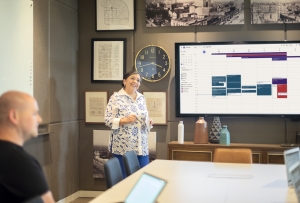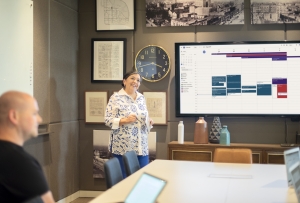Benefits of a Virtual Office Membership
Are you starting a business?
If so, you probably don't have the funds or time yet to get your own office space and the amenities that come with it.
Many new business owners and startups need flexibility in the beginning stages. Coworking spaces offer an affordable place to grow your business. But if you are not ready to commit to a reserved desk or office space, but need the amenities a shared office offers—consider a virtual office membership.
What business support does a virtual office membership provide you?
1. Business Mailing Address
Here at Work Hive, this is the main benefit many of our virtual office members are looking for. Virtual office memberships offer a professional mailing address in a desirable, downtown zip code. Virtual office members gain a physical business location without committing to a lease. This can also ensure your business isn't connected with your home address as you register for a business license.
2. Weekly Mail Forwarding
Virtual office members can choose to have any mail received for their business forwarded weekly to them, wherever that may be. Scan to email is also an option if you prefer getting your mail more quickly.
3. Access to Conference Rooms
When you become a Work Hive virtual office member, you can access our conference rooms for client meetings any time you need. Virtual office members get discounted access to our conference rooms and discounted day passes as well. You can meet with your clients or employees in a professional setting, only paying for the office when you need it!
4. Quick and Easy Set Up
Whether you live near or far from Salt Lake City, Work Hive can easily set up a virtual office membership for you. If you live in a different state, it’s not a problem because everything can be completed online. It takes just a few minutes to sign up online. Once you've signed up, the Work Hive team will reach out with a short form for you to fill out. The form will need to be notarized, or signed in person at Work Hive. After that, you’re set up and ready to go!
5. Cost-Effective
Virtual office memberships save you from renting a commercial space, paying utilities, and buying furniture and equipment. With all the money you will save by choosing a virtual office membership, you can invest it back into your business and its future expansion.
If a virtual office membership sounds like a good fit for your business, visit Work Hive’s membership page to sign up today!
Benefits of a Virtual Office Membership
Are you starting a business?
If so, you probably don't have the funds or time yet to get your own office space and the amenities that come with it.
Many new business owners and startups need flexibility in the beginning stages. Coworking spaces offer an affordable place to grow your business. But if you are not ready to commit to a reserved desk or office space, but need the amenities a shared office offers—consider a virtual office membership.
What business support does a virtual office membership provide you?
1. Business Mailing Address
Here at Work Hive, this is the main benefit many of our virtual office members are looking for. Virtual office memberships offer a professional mailing address in a desirable, downtown zip code. Virtual office members gain a physical business location without committing to a lease. This can also ensure your business isn't connected with your home address as you register for a business license.
2. Weekly Mail Forwarding
Virtual office members can choose to have any mail received for their business forwarded weekly to them, wherever that may be. Scan to email is also an option if you prefer getting your mail more quickly.
3. Access to Conference Rooms
When you become a Work Hive virtual office member, you can access our conference rooms for client meetings any time you need. Virtual office members get discounted access to our conference rooms and discounted day passes as well. You can meet with your clients or employees in a professional setting, only paying for the office when you need it!
4. Quick and Easy Set Up
Whether you live near or far from Salt Lake City, Work Hive can easily set up a virtual office membership for you. If you live in a different state, it’s not a problem because everything can be completed online. It takes just a few minutes to sign up online. Once you've signed up, the Work Hive team will reach out with a short form for you to fill out. The form will need to be notarized, or signed in person at Work Hive. After that, you’re set up and ready to go!
5. Cost-Effective
Virtual office memberships save you from renting a commercial space, paying utilities, and buying furniture and equipment. With all the money you will save by choosing a virtual office membership, you can invest it back into your business and its future expansion.
If a virtual office membership sounds like a good fit for your business, visit Work Hive’s membership page to sign up today!
Grow a Business with Us!
With many benefits to using a coworking space, the #1 benefit may be how it benefits your business's bottom line. In an article on CoworkingResources.com, the author lists four economic benefits of coworking spaces.
Coworking Supports Creatives
Coworking spaces provide a place for small businesses to thrive. The coworking spaces are cheaper than renting a private office to the companies in their beginning stages. Those small businesses bolster creative spirit in local communities and increase employment opportunities, which in the end puts money back into their communities / local economy.
Eliminated Financial Obstacles
As mentioned above, coworking spaces tend to be less expensive than traditional private offices. Small businesses, or people who want to start a business, are often discouraged by the overwhelming overhead costs. Coworking provides the flexibility, in packages and amenities, that these businesses need to flourish.
Retains Local Talent
Coworking spaces keep the innovative, entrepreneurial talent in the community. Rather than heading towards a bigger city, the talent can stay in their place of origin or desire.
“Without coworking offices, many of these daring creatives who possess the wherewithal to start their own ventures would have to relocate to bigger cities where their skills and passions would be diluted by a larger population.”
These innovative and entrepreneurial people and businesses can stay in their local communities to pursue their passion.
Employs Small Businesses
Coworking spaces often hire local restaurants and coffee shops to supply their spaces with all the coffee and food it needs. Some coworking spaces have even been able to exchange coffee for interior design or legal services to the coffee shops, by involving the people working in the space.
“Coworking spaces attract the kind of trustworthy, selfless person that can help collaborative consumption succeed. In a coworking environment, the sharing takes place on a more personal level than in any other kind of work environment, which helps the people in this environment see that there are countless more opportunities available to them when resources are shared. By fostering connection and collaboration, coworking spaces help people gain new skills, save money, and see the world in a brighter light, one that attaches importance to everyone’s contributions.”
5 Ways to Manage Small Business Stress
As a small business owner, what keeps you up at night? Is it the lack of sales? Not enough money? Issues with employees? Or something else?
Unfortunately, the stress will never go away, but learning how to manage it is vital to the success of your business.
In an Entrepreneur.com article, Mike Kappel, a serial entrepreneur, gives five tips on how to manage and combat your stress as a small business owner.
Remember what’s going right.
“You can improve your stress management in business by reminding yourself of the things that are going right. List out all your accomplishments and any small business milestones you’ve achieved. There are probably more than you realize. Don’t neglect even the smallest accomplishments. Put your list somewhere you can easily see it, such as on your desk or the wall. Whenever you feel stressed about all the things that are going wrong, look at your list. Take a moment to remember all the things that have gone right.”
Prioritize your goals.
“Write down everything that you need to complete. Then, rank your tasks from greatest to least. The things you need to do first should be at the top of your list. As you work, focus on the most important tasks. Once you finish those, you can move down the list. You’re essentially creating an agenda for yourself.”
Kappel discusses the anxiety that might come with seeing a long to-do list. He suggests trying to not get overwhelmed with the list and to focus on the next item on your list.
Purge your brain.
It is critical for your well-being to separate work and home, but sometimes it’s impossible. When work will not leave your mind, Kappel suggests writing everything down.
“When my brain won’t shut down, I write everything down that my mind is trying to process. I’ll write down my problem, possible solutions and miscellaneous notes. Sometimes writing everything out can take a while, but it’s worth it. After I write everything down, I can relax and sleep. My brain doesn’t have anything to process because I put all my thoughts in a safe place. I don’t have to worry about my business for a time because I know everything is waiting for me later, and I don’t have to worry about forgetting anything.”
Take breaks.
Sometimes when the stress is beginning to overwhelm you, take a break — step away from the stressor! Kappel suggests that even a ten-minute break can do wonders for you.
“When you take a break, do something that relaxes you. Go for a walk. Get some coffee. Call a friend. Watch a funny video. Don’t do anything business related. When you get back to your business, you will have a clearer mind. You will have fresh energy to tackle the task. And, stepping away might even open your eyes to a new and better way to complete the task.”
Take care of yourself.
“Good health is important when you’re an entrepreneur. Running a business takes a lot out of you. Your small business comes with long nights, early mornings, no weekends and no sick days. Your nonstop life puts strain on your body, and then you add stress on top of that.”
Kappel suggests drinking water, eating regularly, sleep, and exercise! Exercising can help release some of your anxieties and stresses, while contributing to your physical health.
Benefits of a Virtual Office Membership
Are you starting a business?
If so, you probably don't have the funds or time yet to get your own office space and the amenities that come with it.
Many new business owners and startups need flexibility in the beginning stages. Coworking spaces offer an affordable place to grow your business. But if you are not ready to commit to a reserved desk or office space, but need the amenities a shared office offers—consider a virtual office membership.
What business support does a virtual office membership provide you?
1. Business Mailing Address
Here at Work Hive, this is the main benefit many of our virtual office members are looking for. Virtual office memberships offer a professional mailing address in a desirable, downtown zip code. Virtual office members gain a physical business location without committing to a lease. This can also ensure your business isn't connected with your home address as you register for a business license.
2. Weekly Mail Forwarding
Virtual office members can choose to have any mail received for their business forwarded weekly to them, wherever that may be. Scan to email is also an option if you prefer getting your mail more quickly.
3. Access to Conference Rooms
When you become a Work Hive virtual office member, you can access our conference rooms for client meetings any time you need. Virtual office members get discounted access to our conference rooms and discounted day passes as well. You can meet with your clients or employees in a professional setting, only paying for the office when you need it!
4. Quick and Easy Set Up
Whether you live near or far from Salt Lake City, Work Hive can easily set up a virtual office membership for you. If you live in a different state, it’s not a problem because everything can be completed online. It takes just a few minutes to sign up online. Once you've signed up, the Work Hive team will reach out with a short form for you to fill out. The form will need to be notarized, or signed in person at Work Hive. After that, you’re set up and ready to go!
5. Cost-Effective
Virtual office memberships save you from renting a commercial space, paying utilities, and buying furniture and equipment. With all the money you will save by choosing a virtual office membership, you can invest it back into your business and its future expansion.
If a virtual office membership sounds like a good fit for your business, visit Work Hive’s membership page to sign up today!
Cleaning your house, making a dreaded phone call, and responding to all those emails are just some dreaded things you may have to do during your work week. Unfortunately, we cannot avoid these items on our to-do list for ever, because these dreaded tasks are essential. Once you decide to finally tackle them, these tasks tend to ruin your day.
The following some excerpts from Moreno Zugaro’s Medium article, on ways to find motivation in the things you hate doing.
1. Mindset First: It’s Part of the Job
“Whatever you have to do, however annoying, dull, or hard it is — if you have to do it, it matters in some way. Otherwise, you could just not do it and things wouldn’t change. Focus on the outcome of the task and figure out how it fits into the big, strategic picture. Once you recognize what it is useful for, you understand that it is part of your job and it has to be done so you can get where you want in life.”
2. Instant Rewards > Future Rewards
“If you have to do something that won’t pay off until a distant point in the future, look for instant rewards. This can be as easy as allowing yourself some off-time on social media after you’ve cold-called a number of clients or treating yourself to a nice meal once you’ve redesigned your website. It’s much easier to do something you despise when you know that you will be rewarded instantly once you’re done with it.”
3. Doing Something Is Better Than Nothing
“This is also one of the best tactics to fight procrastination. Getting yourself to put in only 15 minutes of work is way easier than forcing yourself to put in a whole day. And in most cases, you won’t stop after 15 minutes, but keep going. The difficult part is getting started, not keeping the momentum. One great way to apply this is the Pomodoro technique — it combines short bursts of highly focused work with small breaks in between. Perfect for anything you’ve been putting off.
If you’re facing a behemoth task, do the following: Break it down into smaller subtasks and commit to putting in a little bit of work — make the initial resistance as small as possible. Step by step, hour by hour, you will dig through the mountain of work, until it isn’t anymore.”
4. Focus on What’s In It For You
Believe it or not, “…Whatever you have to do, there is always something in it for you. Sometimes you just have to look a little closer.
That annoying customer you have to deal with? An opportunity to build your patience, learn to handle special requests, and learn about what type of customer you want or don’t want. Day crammed with appointments? An opportunity to increase your stress tolerance, have short, productive meetings, and learn about scheduling your day better.”
5. Change Your Perspective
“The problem is that when you face an unpleasant task that you have to do, this feeling [of fulfillment] is taken from you. You feel like you have to do it if you like it or not, and as a consequence, your motivation plummets. Don’t worry, you’re not alone. … But here is the cool thing: You can use this mechanism to your advantage. How? By replacing the I have to with I choose to + a reason why. … Retake the power of decision and watch your motivation skyrocket.”
6. Get an Accountability Partner
“The principle of an accountability partner is easy. You have something that you need to do, and now you get yourself someone who holds you accountable. This person can be anyone, although I’d pick someone, you’re close with — you’re much more likely to hold up to your promise. … It doesn’t sound like much, but the added social pressure of promising something to someone close to you and telling them to hold your accountable works wonders. Breaking a promise, you’ve given yourself is one thing — most people are experts when it comes to that (New Year’s Resolutions, anyone?). But losing your face in front of someone else, especially when it’s someone close to you? That’s another story.”
How To Create Your Perfect Productivity Schedule
Has anyone ever told you to have a chock-full morning routine in order to "face the day" and maximize your productivity?
We all have. But it can't be effective for everybody. People work differently and certainly feel differently in the morning.
Some people exercise and make a breakfast and read the newspaper (or the news on their iPad) and french press their coffee all before heading to work, while many others get out of bed and walk out the door and find productivity at other times of day.
Aytekin Tank, founder of JotForm, discusses how you can map out your energy levels throughout the day in order to determine when you are most productive.
Structure
Once you know your patterns, you can begin to schedule your day around that. Tank explains that those in the design and coding industries, for example, plan out their work days very differently than those in finance, teaching, or management.
The types of meetings they schedule are as different as the specific work that they focus on for hours on end in a flow state.
What type of productive time frames does your specific job demand?
What time of day is best to schedule those time frames for you?
Discipline
Once you begin to create a schedule of when you are most productive, you must make it a habit.
Many online calendars have features that allow you to schedule something that day and way every week automatically so that it is out of your hands and allows coworkers to see that you are not to be disturbed during that time period.
Furthermore, decide how your work schedule affects the rest of the day. Knowing when you like to exercise will dictate when you start your workday. Committing yourself to unplugging and relaxing your mind on the weekends will dictate the way you commit to your productive time frames during the workday.
As has been mentioned in a previous post, the new modern structure of offices and work schedules has offered flexibility to employees to employ their personal health habits however is most effective for them and in the most productive times of day.
Start with your own personal map:
- What time of day do you like to exercise?
- What time of day do you feel the most productive?
- What kind of work do you feel the most productive working on?
- What time of day do you wish to make sure you leave the office?
How To Be Productive On Fridays
This post is being written on a Friday afternoon.
The millions on millions of us who work Monday through Friday, leaving the office on Friday afternoon is like crossing the finish line at a marathon. Tears might even be shed.
No wonder, then, that worldwide productivity is so low on Fridays: Everyone is counting down the minutes to their weekend.
Unfortunately, though, a lot of bosses are not loosening deadlines just because their employees cannot wait to leave the office.
So how do you stay productive when your mind is already on your couch watching Netflix?
A recent article in The Muse offered a great 4 Step plan to be more productive on Fridays:
- Schedule smaller tasks
- Plan conversations and meetings on Friday
- Plan the following week
- Use the Pomodoro system
Thinking about the weekend = limited concentration on work = prolonged procrastination.
If projects are not chunked into smaller, more manageable tasks, chances are the project will not even be started. Limited attention and prolonged procrastination are further exacerbated when you spend the whole day sitting in your chair staring at the clock. Number 2 in the list addresses this in that, even though many do not want to hold meetings of any importance on Fridays, getting up from your desk and walking around the office or walking with coworkers to talk about certain tasks helps break up the day and increase your body's blood circulation.
Speaking of breaking up the day, the Pomodoro technique is a timing system that breaks up your day into 25 minute increments such that you feel the pressure of time running out and feel compelled to complete much more than you might have left to your own devices. It gives structure to a mind that is wandering freely through the eminent forest of free time.
Speaking of mental structure, planning your next week can be a great way to bridge the productivity gap between Friday and Monday. It is a quite uncommon practice, but it takes minimal time and provides great mental relief come Monday morning when you are back in the office.
Though it is not necessarily a project that you were tasked to complete that Friday, it is still a helpful way for your mind to reflect on what you have completed, what is yet to be completed, and the order in which the subsequent tasks ought to be prioritized, which decreases the amount of time spent on Monday morning getting organized and planning for the day.
It also makes you feel more accomplished and organized as you leave the office on Friday.
What do you think?
How do you stay productive and push through your Friday?
Part II: Leading Your Business During Uncertain Times
“Sailors navigating tricky winds, shifting tides, and mercurial weather systems prepare their vessels so they can sail on safely and purposefully, and companies can do the same. Rather than simply reacting instinctively and responding to the informational noise detected by their instruments, leaders can move swiftly and proactively to alter their course and chart a new one — and capitalize on dislocations in the market.” – Will Jackson-Moore, Heather Swanston, and Mohamed Kande
This week, we’re finishing our two-part series on leading your business during uncertain times.
Adjusting to Tax and Regulation Reform
One of the biggest drivers of the current uncertainty is the truly complex landscape of tax and regulation reform. In a range of large industries, the regulatory situation is volatile and prone to significant change. Many organizations have found that these shifts impact their industry, the specific markets in which they operate, and the general environment for business. Unfortunately, hiding under a rock is not a suitable option. In order to be resilient to shifts in the tax and regulatory environment, companies must get ahead of the changes and, where appropriate, work with industry peers and government to improve outcomes.
For example, embracing technological solutions can help companies manage compliance issues while they assess the longer-term impact of other changes. Above all, being in a position to respond effectively will enable a business to continue focusing on its trading environment and not be further disrupted by legal or regulatory challenges at an already difficult time.
Capital Strength
Companies can implement capabilities-driven strategies, invest in human capital, and execute deals effectively only if they rest on a strong financial foundation. But finance has its own heuristics in a time of uncertainty. Commercial organizations are often slow to react to changes to their forecasts. Working capital often increases, consuming more cash and effectively restricting liquidity. Companies often become motivated sellers at a time when asset prices are low. To ensure effective action, it is vital not just for finance to act as an operationally involved partner and conscience of the business, but for all key operational functions, including commercial, procurement, and supply chain, to be actively engaged.
By harnessing data and information technologies to run scenarios involving their business, companies can review and challenge economic, business, and sales projections — and continually feed the results into updated forecasts.
Act Now
No one action, by itself, can dispel a heavy cloud of uncertainty or significantly mitigate its impact. But if organizations can get out of their defensive crouch and assume a more aggressive stance, they have a better chance of maintaining their balance and shaping their future. Building and harnessing the mutually reinforcing attributes of optionality, agility, and resilience will enable leaders to adopt the strategies and mind-sets that allow them to succeed in the full spectrum of uncertain outcomes. Pursuing this path takes a lot of courage. Companies must consciously lean into changes and counterintuitive activities in the precise moments when it is most uncomfortable to do so, or when the forces of inertia and gravity are pushing them toward a predictable outcome.
Rather than being an excuse to detach or check out, uncertainty should be a spur to engage and build sustainable advantage.
Part I: Leading Your Business During Uncertain Times
Uncertainty is found everywhere in life—the weather, the economy, the actions of others, etc. That uncertainty can rise and fall, just like the weather. Currently, business owners and employees are facing a series of uncertain alerts.
If you are a leader of a company, or a team, and need some guidance to leading during this time, we’ve got some approaches to help your company adapt.
“Sailors navigating tricky winds, shifting tides, and mercurial weather systems prepare their vessels so they can sail on safely and purposefully, and companies can do the same. Rather than simply reacting instinctively and responding to the informational noise detected by their instruments, leaders can move swiftly and proactively to alter their course and chart a new one — and capitalize on dislocations in the market.” – Will Jackson-Moore, Heather Swanston, and Mohamed Kande
Dynamic Strategy
During uncertain times, the greatest challenge of managing is that the potential outcomes are much more numerous than is typically expected—for the economy at large, and for the behavior of competitors and consumers. In order to be more resilient, leaders will need to be as clear about what they will not do as they are about the initiatives they will pursue.
Sundar Subramanian and Anand Rao have written, strategic decision making has to become more dynamic and probabilistic. In order to build competitive advantage, company leaders will need to define strategy, then test and tweak it to adjust to internal and external changes.
Investing in the Workforce
During uncertain times, companies will reduce head count, put hiring freezes in place, and leave positions open. Yet, simply freezing activity means companies can miss out on filling critical needs and areas. Instead, companies should recognize the potential of longtime employees. By investing in efforts to make the existing workforce more agile and resilient to changes in the environment can boost an organization’s capacity to thrive in uncertain times.
Create Values with Deals
Uncertainty tends to paralyze deal making or to push companies into transactions that are defensive and reactive. But companies that are sufficiently agile to execute transactions when they can, rather than when they have to, will find that deals present occasions to boost growth and pull ahead of rivals. Because more motivated sellers appear in uncertain times, companies can potentially take advantage of deal flow from organizations that are divesting assets. It is no surprise that private equity firms tend to do their best deals and create the most value by buying at the trough of a cycle, when both multiples and profits are depressed.










